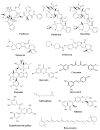Anticancer Drug Discovery Based on Natural Products: From Computational Approaches to Clinical Studies
- PMID: 38255306
- PMCID: PMC10813144
- DOI: 10.3390/biomedicines12010201
Anticancer Drug Discovery Based on Natural Products: From Computational Approaches to Clinical Studies
Abstract
Globally, malignancies cause one out of six mortalities, which is a serious health problem. Cancer therapy has always been challenging, apart from major advances in immunotherapies, stem cell transplantation, targeted therapies, hormonal therapies, precision medicine, and palliative care, and traditional therapies such as surgery, radiation therapy, and chemotherapy. Natural products are integral to the development of innovative anticancer drugs in cancer research, offering the scientific community the possibility of exploring novel natural compounds against cancers. The role of natural products like Vincristine and Vinblastine has been thoroughly implicated in the management of leukemia and Hodgkin's disease. The computational method is the initial key approach in drug discovery, among various approaches. This review investigates the synergy between natural products and computational techniques, and highlights their significance in the drug discovery process. The transition from computational to experimental validation has been highlighted through in vitro and in vivo studies, with examples such as betulinic acid and withaferin A. The path toward therapeutic applications have been demonstrated through clinical studies of compounds such as silvestrol and artemisinin, from preclinical investigations to clinical trials. This article also addresses the challenges and limitations in the development of natural products as potential anti-cancer drugs. Moreover, the integration of deep learning and artificial intelligence with traditional computational drug discovery methods may be useful for enhancing the anticancer potential of natural products.
Keywords: anticancer drug discovery; clinical trials; computational drug design; drug design; molecular dynamics; natural product.
Conflict of interest statement
All authors declare no competing interests with the work presented in the manuscript.
Figures




Similar articles
-
Natural Products for Drug Discovery in the 21st Century: Innovations for Novel Drug Discovery.Int J Mol Sci. 2018 May 25;19(6):1578. doi: 10.3390/ijms19061578. Int J Mol Sci. 2018. PMID: 29799486 Free PMC article. Review.
-
Recent Trends in Computer-aided Drug Design for Anti-cancer Drug Discovery.Curr Top Med Chem. 2023;23(30):2844-2862. doi: 10.2174/0115680266258467231107102643. Curr Top Med Chem. 2023. PMID: 38031798 Review.
-
m6A modification: recent advances, anticancer targeted drug discovery and beyond.Mol Cancer. 2022 Feb 14;21(1):52. doi: 10.1186/s12943-022-01510-2. Mol Cancer. 2022. PMID: 35164788 Free PMC article. Review.
-
From Traditional Ethnopharmacology to Modern Natural Drug Discovery: A Methodology Discussion and Specific Examples.Molecules. 2022 Jun 24;27(13):4060. doi: 10.3390/molecules27134060. Molecules. 2022. PMID: 35807306 Free PMC article. Review.
-
[Development of antituberculous drugs: current status and future prospects].Kekkaku. 2006 Dec;81(12):753-74. Kekkaku. 2006. PMID: 17240921 Review. Japanese.
Cited by
-
Hydrogels with Essential Oils: Recent Advances in Designs and Applications.Gels. 2024 Sep 30;10(10):636. doi: 10.3390/gels10100636. Gels. 2024. PMID: 39451288 Free PMC article. Review.
-
Modulating the p53-MDM2 pathway: the therapeutic potential of natural compounds in cancer treatment.EXCLI J. 2024 Nov 22;23:1397-1439. doi: 10.17179/excli2024-7791. eCollection 2024. EXCLI J. 2024. PMID: 39764218 Free PMC article. Review.
-
Therapeutic Potential of Plant- and Marine-Derived Bioactive Compounds in Prostate Cancer: Mechanistic Insights and Translational Applications.Pharmaceuticals (Basel). 2025 Feb 20;18(3):286. doi: 10.3390/ph18030286. Pharmaceuticals (Basel). 2025. PMID: 40143065 Free PMC article. Review.
-
Discovery of natural scaffolds as HER2 inhibitors for breast cancer: virtual screening, molecular dynamics, and biological characterization with selectivity profiling.Sci Rep. 2025 Jul 17;15(1):25883. doi: 10.1038/s41598-025-11177-6. Sci Rep. 2025. PMID: 40670559 Free PMC article.
-
Advances in Precision Medicine Approaches for Colorectal Cancer: From Molecular Profiling to Targeted Therapies.ACS Pharmacol Transl Sci. 2024 Mar 19;7(4):967-990. doi: 10.1021/acsptsci.4c00008. eCollection 2024 Apr 12. ACS Pharmacol Transl Sci. 2024. PMID: 38633600 Free PMC article. Review.
References
-
- Alhosin M., Sharif T., Mousli M., Etienne-Selloum N., Fuhrmann G., Schini-Kerth V.B., Bronner C. Down-Regulation of UHRF1, Associated with Re-Expression of Tumor Suppressor Genes, Is a Common Feature of Natural Compounds Exhibiting Anti-Cancer Properties. J. Exp. Clin. Cancer Res. 2011;30:41. doi: 10.1186/1756-9966-30-41. - DOI - PMC - PubMed
Publication types
LinkOut - more resources
Full Text Sources

